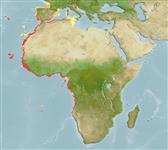>
Eupercaria/misc (Various families in series Eupercaria) >
Haemulidae (Grunts) > Haemulinae
Etymology: Pomadasys: Greek, poma, -atos = cover, operculum + Greek, dasys = with hair (Ref. 45335).
Environment: milieu / climate zone / depth range / distribution range
Ökologie
seewasser; brackwasser demersal; tiefenbereich 10 - 100 m (Ref. 6946). Subtropical; 47°N - 14°S, 27°W - 14°E
Size / Gewicht / Alter
Maturity: Lm ? range ? - ? cm
Max length : 53.5 cm TL Männchen/unbestimmt; (Ref. 104752); common length : 25.0 cm TL Männchen/unbestimmt; (Ref. 6946); max. veröff. Alter: 7 Jahre (Ref. 52657)
Kurzbeschreibung
Morphologie | Morphometrie
Rückenflossenstacheln (insgesamt): 12; Rückenflossenweichstrahlen (insgesamt): 15-16; Afterflossenstacheln 3; Afterflossenweichstrahlen: 11 - 13; Wirbelzahl: 27. Diagnosis: body oblong; snout short, about equal to eye diameter; mouth small, maxilla not reaching anterior edge of eye; 2 anterior pores on chin, followed by a median pit; third anal fin spine equal or longer than second; 11-13 anal soft rays; caudal fin forked; scales slightly ctenoid; 7-8 scale rows between lateral line and middle of spinous dorsal-fin base (Ref. 57395).
Coloration: back dark brown, silvery white on belly; sometimes large dark spots on back and flanks, but never small spots or bands; a black spot at upper angle of opercle (Ref. 57395).
Found over hard bottom (Ref. 2683, 57395) and sand (Ref. 57395). Enters estuaries and lagoons at sexual maturation (Ref. 57395). Feeds on bottom and near-bottom invertebrates (Ref. 5535).
Life cycle and mating behavior
Geschlechtsreife | Fortpflanzung | Ablaichen | Eier | Fecundity | Larven
Oviparous, distinct pairing during breeding (Ref. 205).
Roux, C., 1990. Haemulidae. p. 783-788. In J.C. Quero, J.C. Hureau, C. Karrer, A. Post and L. Saldanha (eds.) Check-list of the fishes of the eastern tropical Atlantic (CLOFETA). JNICT, Lisbon; SEI, Paris; and UNESCO, Paris. Vol. 2. (Ref. 6946)
IUCN Rote Liste Status (Ref. 130435)
Bedrohung für Menschen
Harmless
Nutzung durch Menschen
Fischereien: weniger kommerziell
Mehr Information
ReferenzenAquakulturAquakultur ProfilZuchtlinienGenetikElectrophoresesVererbbarkeitKrankheitenVerarbeitungNutrientsMass conversion
PartnerBilderStamps, Coins Misc.LauteCiguateraGeschwindigkeitSchwimmstilKiemenoberflächeOtolithsGehirngrößeSehfähigkeit
Tools
Zusatzinformationen
Download XML
Internet Quellen
Estimates based on models
Preferred temperature (Ref.
123201): 18.3 - 27.9, mean 23.1 °C (based on 118 cells).
Phylogenetic diversity index (Ref.
82804): PD
50 = 0.5000 [Uniqueness, from 0.5 = low to 2.0 = high].
Bayesian length-weight: a=0.01349 (0.01072 - 0.01697), b=2.98 (2.94 - 3.02), in cm total length, based on LWR estimates for this species (Ref.
93245).
Trophic level (Ref.
69278): 3.8 ±0.52 se; based on food items.
Generation time: 5.1 ( na - na) years. Estimated as median ln(3)/K based on 1
growth studies.
Widerstandsfähigkeit (Ref.
120179): mittel, Verdopplung der Population dauert 1,4 - 4,4 Jahre. (Tmax=7; K=0.22).
Fishing Vulnerability (Ref.
59153): Moderate vulnerability (40 of 100).
Climate Vulnerability (Ref.
125649): Low to moderate vulnerability (33 of 100).
Nutrients (Ref.
124155): Calcium = 64.3 [13.4, 129.4] mg/100g; Iron = 0.934 [0.503, 1.780] mg/100g; Protein = 19.6 [17.7, 21.4] %; Omega3 = 0.377 [0.203, 0.623] g/100g; Selenium = 26.2 [14.0, 47.0] μg/100g; VitaminA = 11.9 [5.1, 27.0] μg/100g; Zinc = 0.791 [0.559, 1.130] mg/100g (wet weight);
